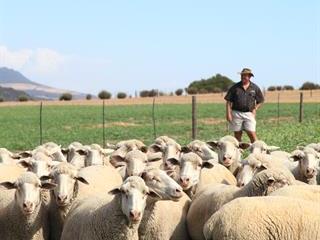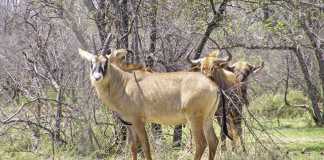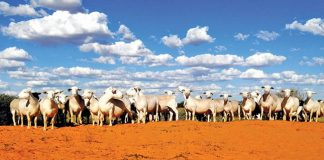
The Engelbrecht family of Groenkol Boerdery near Clanwilliam is well known in the Rooibos industry. Willem Engelbrecht’s grandfather, Willie, started farming Rooibos in the 1950s, and was one of the founding farmers and members of the Clanwilliam Tea Co-operative.
Willem’s father, Oubaas, who was skilled in mechanics, built the first Rooibos machine harvester in the country. Under Willem’s leadership, Groenkol broke away from Rooibos Ltd and became one of the first Rooibos Estates to sell its tea on the international market.
While their Rooibos business was thriving, Willem felt it was time to become less dependent on tea. “The market is too volatile. When prices are low, farmers downscale their production, and when they go up, everybody gets back on board.”
One fairly obvious solution would be to hold stock back when the market was oversupplied, but most Rooibos farmers do not have the storage facilities or the infrastructure to do this, he explains.
Diversifying from tea to sheep
Willem has a keen interest in livestock and has always kept a few cattle and sheep on the farm. It made sense to him to expand sheep production to spread Rooibos- related market risks. “I was looking for an intensive production system that would be easy to manage, didn’t need too much labour, and complemented the other farming activities. It also had to boost farm cash flow,” he says.
While thinking about how to diversify, Willem remembered the old saying, “Man can feed sheep, but only God can feed cattle”. “This really boils down to the fact that it’s easier to supply sheep with additional feed than it is to feed cattle. And it’s especially true in our semi-arid production conditions with the additional consideration that we’re so isolated from feed-producing regions,” he explains.
Most farmers in the Clanwilliam region farm sheep in extensive production systems. Willem wanted to run sheep intensively. In his search for a suitable system, he came across an article describing the way some US smallstock farmers ran intensive sheep production systems on pastures under centre pivot irrigation.
Willem liked the idea of using a centre pivot, the most efficient irrigation method for his conditions. Based on this farming model, the irrigated area under pivot is sectioned into quadrants and the sheep rotated through the quadrants. However, it was much hotter on Willem’s farm than it was in Lincoln, Nebraska in the US, where the model was in use, and Groenkol has sandy soil, so crops have to be irrigated at least every second day.
“With the system the way it was, I would have had to irrigate pastures while sheep were grazing under the irrigation,” he says. This posed a health risk to the sheep. In addition, four of Willem’s lambs were trampled by the ‘walking’ pivot shortly after the system was set up.
There were a number of other snags in the original design: the pivot had to move from one quadrant to another, and Willem did not know how to do this without increasing the labour requirements of the system or creating corridors through which the sheep could also move.
“Mostly we irrigate at night, and we would have had to employ a permanent worker just to open and close the gates at night,” Willem says. He also did not like the idea of having to move drinking troughs and feeding cribs from one quadrant to another. Because of the extreme heat, provision would have had to be made for shade in every quadrant. The grazing cycle has to be a minimum of 21 days because parasite life cycles cannot be broken in less time than this.
Modifications
The solution to these problems came from a friend of Willem’s, a fellow farmer from Cradock in the Eastern Cape. He advised Willem to make gates out of conveyer belting along the quadrant fences. The conveyor belt is folded double and opens for the pivot wheels both clockwise and anti-clockwise. The pivot moves around through the gates without the need for any manual opening or closing between the quadrants.
Willem decided to put in a passage running from the pivot centre through two quadrants down to a separate kraal. Drinking troughs, feeders and shade shelters are set up and the animals have unlimited access to the kraal. This design solved most of Willem’s problems with the original system.
The passage allows him to move the sheep into the kraal daily with minimal disturbance. The pastures are closed off at night when the sheep are sent to the kraal, and are opened again at about 10am. The pivot runs during the night, from 6pm to 6am.
“Many people are under the impression that it’s best to send sheep out early in the morning to graze. However, at this time of the day, protein levels are high in green pastures, but energy levels are low, and young animals need plenty of energy. Plants are in a positive protein/negative energy phase in the morning as they’ve used up most of their energy during night-time respiration.
The energy content increases during the day and the plant produces sugars and carbohydrates during photosynthesis. This means that young animals benefit from eating later in the day.”
Pastures
Willem identifies fodder flow as critical to the success of a system such as this. “You need to maintain the ewes in a positive condition at the lowest possible cost. We’re experimenting with different crops so that we can identify what works best in our conditions. The pasture grasses have to withstand our warm climatic conditions and have some saline resistance, because our water is so brackish.”
Brazilian grass (Mombasa) is producing well in the current hot weather. This grass has production peaks in January and February and needs a rotation of between 21 days and 28 days. The pasture is mixed with tall fescue, cocksfoot, red and white clovers and perennial ryegrass. Willem uses a no-till planter to oversow pastures.
Willem plants the grass clover mixture under one pivot and the Brazilian grass in another system to ease management. One pivot covers an area of 11,5ha. He plans to install three pivots to make the system fully operational. The pastures are, however, not enough to supply the full production requirements of his ewes. “We’ve calculated that the pastures will be able to supply only about half the daily dry matter requirement of our ewes. That is if she is eating the whole time for twelve hours a day. The remainder of the dry matter requirement must be supplied through additional feed, such as protein licks and hay.”
Currently, Willem and his team use a molasses-based lick mixed with oat hay.
Email Willem Engelbrecht at [email protected].













